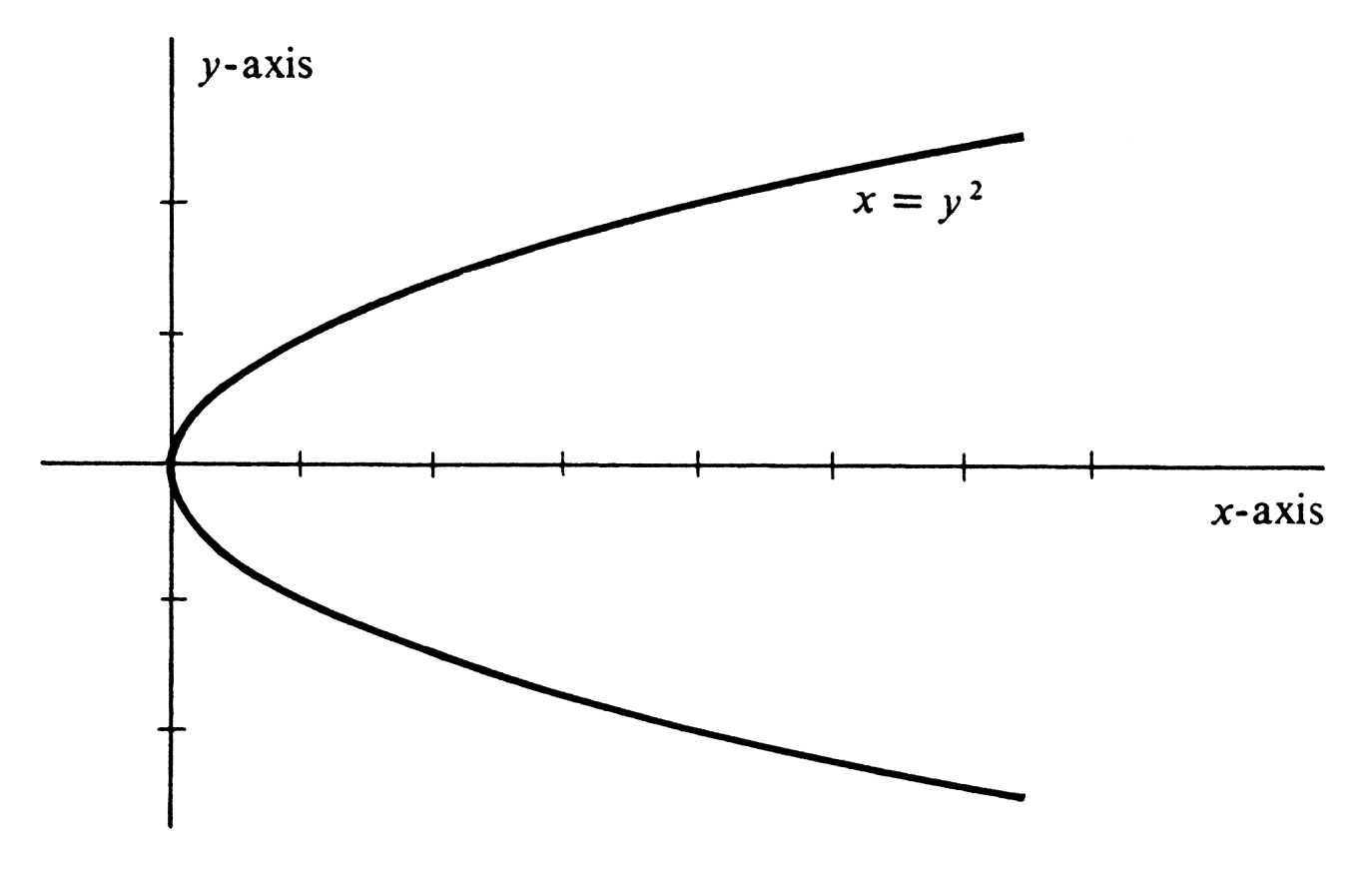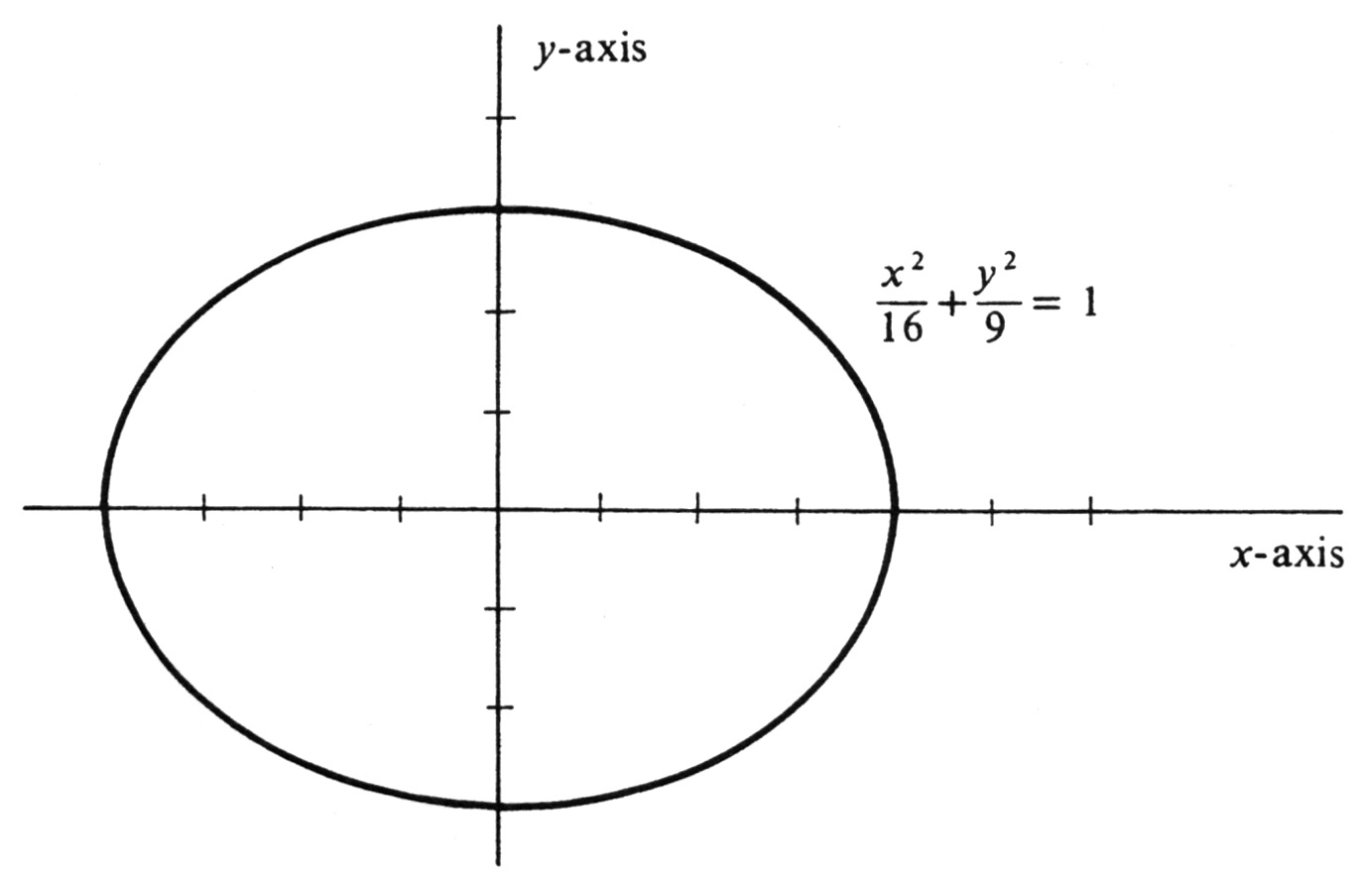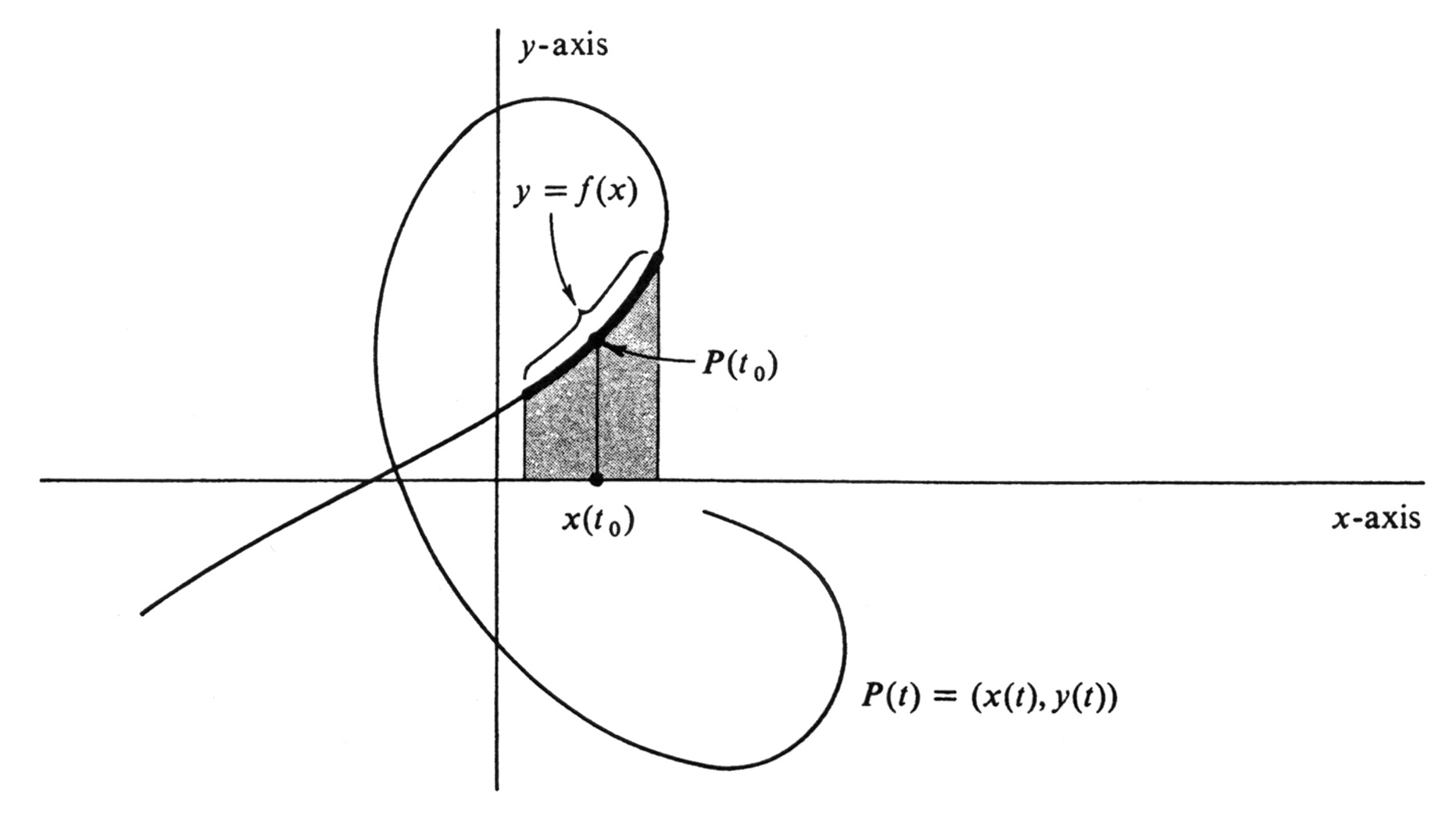guide:956af30164: Difference between revisions
No edit summary |
mNo edit summary |
||
| Line 32: | Line 32: | ||
\newcommand{\mathds}{\mathbb} | \newcommand{\mathds}{\mathbb} | ||
</math></div> | </math></div> | ||
When we speak of the plane in this book, we assume, unless otherwise stated, that a pair of coordinate axes has been chosen. As a result, we identify the set of points in the plane with the set <math>R^2</math> of all ordered pairs of real numbers. A convenient notation for a function <math>P</math> whose domain is an interval <math>I</math> of real numbers and whose range is a subset of the plane is <math>P : I \rightarrow R^2</math>. Every function <math>P : I \rightarrow R^2</math> defines two '''coordinate functions,''' the functions which assign to every <math>t</math> in <math>I</math> the two coordinates of the point <math>P(t)</math>. If we denote the first coordinate function by <math>f</math>, and the second one by <math>g</math>, then they are defined by the equation | When we speak of the plane in this book, we assume, unless otherwise stated, that a pair of coordinate axes has been chosen. As a result, we identify the set of points in the plane with the set <math>R^2</math> of all ordered pairs of real numbers. A convenient notation for a function <math>P</math> whose domain is an interval <math>I</math> of real numbers and whose range is a subset of the plane is <math>P : I \rightarrow R^2</math>. Every function <math>P : I \rightarrow R^2</math> defines two '''coordinate functions,''' the functions which assign to every <math>t</math> in <math>I</math> the two coordinates of the point <math>P(t)</math>. If we denote the first coordinate function by <math>f</math>, and the second one by <math>g</math>, then they are defined by the equation | ||
| Line 40: | Line 38: | ||
<math display="block"> | <math display="block"> | ||
\begin{equation} | \begin{equation} | ||
P(t) = (f(t), g(t)), \;\;\;\mbox{for every $t$ in | P(t) = (f(t), g(t)), \;\;\;\mbox{for every $t$ in $I$.} | ||
\label{eq10.1.1} | \label{eq10.1.1} | ||
\end{equation} | \end{equation} | ||
| Line 58: | Line 56: | ||
<math display="block"> | <math display="block"> | ||
P(t) = (x(t), y(t)), \;\;\;\mbox{for every $t$ in | P(t) = (x(t), y(t)), \;\;\;\mbox{for every $t$ in $I$.} | ||
</math> | </math> | ||
| Line 83: | Line 81: | ||
</math> | </math> | ||
for every <math>t</math> in some interval <math>I</math> which is the common domain of the continuous functions <math>x</math> and <math>y</math>. If <math>t</math> is regarded as an independent variable, it is called the '''parameter''' of the parametrized curve. | for every <math>t</math> in some interval <math>I</math> which is the common domain of the continuous functions <math>x</math> and <math>y</math>. If <math>t</math> is regarded as an independent variable, it is called the '''parameter''' of the parametrized curve. | ||
'''Example''' | '''Example''' | ||
Draw the curve defined parametrically by | Draw the curve defined parametrically by | ||
| Line 126: | Line 126: | ||
\left \{ \begin{array}{l} | \left \{ \begin{array}{l} | ||
x = t,\\ | x = t,\\ | ||
y = f(t), \;\;\;\mbox{and $t$ is in the domain of | y = f(t), \;\;\;\mbox{and $t$ is in the domain of $f$.} | ||
\end{array} | \end{array} | ||
\right . | \right . | ||
| Line 136: | Line 136: | ||
Hence the graph of <math>f</math> is defined parametrically by equations (2). | Hence the graph of <math>f</math> is defined parametrically by equations (2). | ||
A function <math>P : I \rightarrow R^2</math> is '''differentiable at''' <math>t_0</math> if the derivatives of both coordinate functions exist at <math>t_0</math>. Moreover, following the usual style, we say that <math>P</math> is a '''differentiable function''' if it is differentiable at every number in its domain. This terminology is also applied to parametrized curves. That is, a curve defined parametrically by <math>P : I \rightarrow R^2</math> is said to be differentiable at <math>t_0</math>, or simply differentiable, according as <math>P</math> is differentiable at <math>t_0</math>, or is a differentiable function. | A function <math>P : I \rightarrow R^2</math> is '''differentiable at''' <math>t_0</math> if the derivatives of both coordinate functions exist at <math>t_0</math>. Moreover, following the usual style, we say that <math>P</math> is a '''differentiable function''' if it is differentiable at every number in its domain. This terminology is also applied to parametrized curves. That is, a curve defined parametrically by <math>P : I \rightarrow R^2</math> is said to be differentiable at <math>t_0</math>, or simply differentiable, according as <math>P</math> is differentiable at <math>t_0</math>, or is a differentiable function. | ||
<span id="eq10.1.3"/> | <span id="eq10.1.3"/> | ||
'''Example''' | '''Example''' | ||
Draw and identify the curve <math>C</math> defined parametrically by | Draw and identify the curve <math>C</math> defined parametrically by | ||
| Line 205: | Line 208: | ||
for every <math>t</math> in some subinterval of <math>I</math> containing <math>t_0</math> in its interior. If such a function does exist, we shall say that <math>y</math> | for every <math>t</math> in some subinterval of <math>I</math> containing <math>t_0</math> in its interior. If such a function does exist, we shall say that <math>y</math> is a differentiable function of <math>x</math> on the parametrized curve <math>P(t) = (x(t), y(t))</math> in a neighborhood of the point <math>P(t_0)</math>. Applying the Chain Rule to equation (4), we obtain | ||
<math display="block"> | <math display="block"> | ||
| Line 234: | Line 237: | ||
'''Example''' | '''Example''' | ||
Find the slope, when <math>t = \frac{\pi}{3}</math>, of the parametrized ellipse in Example 2. The parametrization is defined by the equations | Find the slope, when <math>t = \frac{\pi}{3}</math>, of the parametrized ellipse in Example 2. The parametrization is defined by the equations | ||
| Line 301: | Line 305: | ||
</div> | </div> | ||
==General references== | ==General references== | ||
{{cite web |title=Crowell and Slesnick’s Calculus with Analytic Geometry|url=https://math.dartmouth.edu/~doyle/docs/calc/calc.pdf |last=Doyle |first=Peter G.|date=2008 |access-date=Oct 29, 2024}} | {{cite web |title=Crowell and Slesnick’s Calculus with Analytic Geometry|url=https://math.dartmouth.edu/~doyle/docs/calc/calc.pdf |last=Doyle |first=Peter G.|date=2008 |access-date=Oct 29, 2024}} | ||
Revision as of 01:15, 21 November 2024
When we speak of the plane in this book, we assume, unless otherwise stated, that a pair of coordinate axes has been chosen. As a result, we identify the set of points in the plane with the set [math]R^2[/math] of all ordered pairs of real numbers. A convenient notation for a function [math]P[/math] whose domain is an interval [math]I[/math] of real numbers and whose range is a subset of the plane is [math]P : I \rightarrow R^2[/math]. Every function [math]P : I \rightarrow R^2[/math] defines two coordinate functions, the functions which assign to every [math]t[/math] in [math]I[/math] the two coordinates of the point [math]P(t)[/math]. If we denote the first coordinate function by [math]f[/math], and the second one by [math]g[/math], then they are defined by the equation
Conversely, of course, every ordered pair of real-valued functions [math]f[/math] and [math]g[/math] with an interval [math]I[/math] as common domain defines a function [math]P : I \rightarrow R^2[/math] by equation (1). Since the first and second coordinates of an element of [math]R^2[/math] are usually the [math]x[/math]- and [math]y[/math]-coordinates, respectively, we may alternatively define a function [math]P : I \rightarrow R^2[/math] by a pair of equations
where [math]f[/math] and [math]g[/math] are real-valued functions with domain [math]I[/math]. Then, for every [math]t[/math] in [math]I[/math], we have [math]P(t) = (x, y) = (f(t), g(t))[/math]. It is also common practice to denote the coordinate functions themselves by [math]x[/math] and [math]y[/math]. When this is done, we do not hesitate to write the equations [math]x = x(t)[/math] and [math]y = y(t)[/math], and the function [math]P : I \rightarrow R^2[/math] is defined by
A function [math]P : I \rightarrow R^2[/math] is said to be continuous at [math]t_0[/math] if both coordinate functions are continuous at [math]t_0[/math]. If the coordinate functions are denoted by [math]x[/math] and [math]y[/math], then we define
As a result, the definition of continuity for [math]P[/math] is entirely analogous to that for a real-valued function: [math]P[/math] is continuous at [math]t_0[/math] if [math]t_0[/math] is in the domain of [math]P[/math] and if [math]\lim_{t \rightarrow t_0} P(t) = P(t_0)[/math]. As before, the function [math]P[/math] is simply said to be continuous if it is continuous at every number in its domain. A curve in the plane is by definition a subset of [math]R^2[/math] which is the range of some continuous function [math]P : I \rightarrow R^2[/math]. Every curve is the range of many such functions, and, as a result, it is necessary to choose our terminology carefully. We shall call a continuous function [math]P : I \rightarrow R^2[/math], a parametrization of the curve [math]C[/math] which is the range of [math]P[/math], and we shall say that [math]C[/math] is parametrically defined by [math]P : I \rightarrow R^2[/math]. The points of the curve [math]C[/math] obviously consist of the set of all points [math]P(t)[/math], for every [math]t[/math] in [math]I[/math]. By a parametrized curve we shall mean the range of a specified continuous function [math]P : I \rightarrow R^2[/math]. Speaking more casually, we shall refer to the curve defined parametrically by
or, equivalently, to the curve defined parametrically by the equations
for every [math]t[/math] in some interval [math]I[/math] which is the common domain of the continuous functions [math]x[/math] and [math]y[/math]. If [math]t[/math] is regarded as an independent variable, it is called the parameter of the parametrized curve.
Example
Draw the curve defined parametrically by
This is, of course, also the curve defined by the equations
It is plotted in Figure 1. Since the set of all points [math](x, y)[/math] which satisfy the above two equations is equal to the set of all points [math](x, y)[/math] such that [math]x = y^2[/math], we recognize the curve as a parabola.
| t | (x, y) |
| 0 | (0, 0) |
| 1 | (1, 1) |
| 2 | (4, 2) |
\medskip It is worth noting that every curve which we have previously encountered as the graph of a continuous function [math]f[/math] can be defined parametrically. The graph is the set of all points [math](x, y)[/math] such that [math]x[/math] is in the domain of [math]f[/math] and such that [math]y = f(x)[/math]. This set is obviously equal to the set of all points [math](x, y)[/math] such that
Hence the graph of [math]f[/math] is defined parametrically by equations (2).
A function [math]P : I \rightarrow R^2[/math] is differentiable at [math]t_0[/math] if the derivatives of both coordinate functions exist at [math]t_0[/math]. Moreover, following the usual style, we say that [math]P[/math] is a differentiable function if it is differentiable at every number in its domain. This terminology is also applied to parametrized curves. That is, a curve defined parametrically by [math]P : I \rightarrow R^2[/math] is said to be differentiable at [math]t_0[/math], or simply differentiable, according as [math]P[/math] is differentiable at [math]t_0[/math], or is a differentiable function.
Example
Draw and identify the curve [math]C[/math] defined parametrically by
for every real number [math]t[/math]. If [math](x, y)[/math] is an arbitrary point on the curve, then
for some value of [math]t[/math]. Hence, [math]\frac{x}{4} = \cos t[/math] and [math]\frac{y}{3} = \sin t[/math], and, consequently,
Thus for every point [math](x, y)[/math] on the curve, we have shown that
The latter is an equation of the ellipse shown in Figure 2, and it follows that the curve [math]C[/math] is a subset of the ellipse. Conversely, let [math](x, y)[/math] be an arbitrary point on the ellipse. Then [math]|x| \leq 4[/math], and so there exists a number [math]t[/math] such that
[math]x = 4 \cos t[/math]. Since [math]\cos t = \cos(-t)[/math] and [math]\sin t = -\sin(-t)[/math], we may choose [math]t[/math] so that [math]\sin t[/math] and [math]y[/math] have the same sign. Then, solving equation (3) for [math]y[/math] and setting [math]x = 4 \cos t[/math], we obtain
Since [math]y[/math] and [math]\sin t[/math] have the same sign, it follows that [math]y = 3 \sin t[/math]. We have therefore proved that, if [math](x, y)[/math] is an arbitrary point on the ellipse, then there exists a real number [math]t[/math] such that
That is, every point on the ellipse also lies on [math]C[/math]. We have already shown that the converse is true, and we therefore conclude that the parametrized curve [math]C[/math] is equal to the ellipse.
Consider a curve [math]C[/math] defined parametrically by a differentiable function [math]P : I \rightarrow R^2[/math], and let [math]t_0[/math] be an interior point of the interval [math]I[/math]. A typical example is shown in Figure 3. Generally it will not be the case that the whole curve is a function of [math]x[/math], since there may be distinct points on [math]C[/math] with the same [math]x[/math]-coordinate. However, it can happen that a subset of [math]C[/math] containing the point [math]P(t_0)[/math] is a differentiable function. Such a subset is shown in Figure 3, drawn with a heavy line. Thus if [math]P(t) = (x(t), y(t))[/math] for every [math]t[/math] in [math]I[/math], then there may exist a differentiable function [math]f[/math] such that
for every [math]t[/math] in some subinterval of [math]I[/math] containing [math]t_0[/math] in its interior. If such a function does exist, we shall say that [math]y[/math] is a differentiable function of [math]x[/math] on the parametrized curve [math]P(t) = (x(t), y(t))[/math] in a neighborhood of the point [math]P(t_0)[/math]. Applying the Chain Rule to equation (4), we obtain
Hence
for every [math]t[/math] in the subinterval, for which [math]x'(t) \neq 0[/math]. If we write [math]y = f(x)[/math] and use the differential notation for the derivative, formula (5) becomes
It should be apparent that [math]f'(x(t))[/math], or, equivalently, [math]\frac{dy}{dx}[/math] at [math]t[/math], is equal to the slope of the curve [math]C[/math] at the point [math]P(t)[/math].
Example
Find the slope, when [math]t = \frac{\pi}{3}[/math], of the parametrized ellipse in Example 2. The parametrization is defined by the equations
We shall assume the analytic result that [math]y[/math] is defined as a differentiable function of [math]x[/math] in a neighborhood of the point
Since
one can see by simply looking at Figure 2 that this should certainly be true since the curve passes smoothly through the point and, in the immediate vicinity of the point, does not double back on itself. We have
and so
Hence, by formula (6), the slope is equal to
The problem of giving analytic conditions which imply that [math]y[/math] is a differentiable function of [math]x[/math] on a parametrized curve in the neighborhood of a point is akin to the problem of determining when an equation [math]F(x, y) = c[/math] implicitly defines [math]y[/math] as a differentiable function of [math]x[/math] in a neighborhood of a point. As mentioned on page 81, the latter is solved by the Implicit Function Theorem, and the techniques needed here are similar. As a final example, let us consider the curve traced by a point fixed on the circumference of a wheel as the wheel rolls along a straight line. We take the [math]x[/math]-axis for the straight line. The radius of the wheel we denote by [math]a[/math], and the point on the circumference by [math](x,y)[/math]. If we assume that the point passes through the origin as the wheel rolls by to the right, then the curve is defined parametrically by the equations
where the parameter [math]\theta[/math] is the radian measure of the angle with vertex the center of the wheel, initial side the half-line pointing vertically downward, and terminal side the half-line through [math](x, y)[/math] (see Figure 4). (An alternative geometric interpretation of the parameter is that [math]a\theta[/math] is the coordinate of the point of tangency of the wheel on the [math]x[/math]-axis.) The curve is called a cycloid. Note that the parametric equations are quite simple, whereas it would be difficult to express [math]y[/math] as a function of [math]x[/math].
General references
Doyle, Peter G. (2008). "Crowell and Slesnick's Calculus with Analytic Geometry" (PDF). Retrieved Oct 29, 2024.



